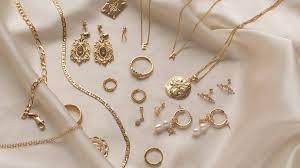Introduction
Jewelry, with its exquisite beauty and profound symbolism, has played an integral role in human history for thousands of years. From ancient civilizations to modern fashion, jewelry serves as a tangible representation of culture, status, and personal expression. This exploration will journey through the origins, evolution, and enduring significance of jewelry, celebrating its power to captivate, inspire, and connect.

Origins of Jewelry
The origins of jewelry can be traced back to prehistoric times when early humans adorned themselves with natural materials like bones, shells, and feathers. These adornments were not just aesthetic; they held spiritual, cultural, and even protective significance. As civilizations progressed, so did the materials and techniques used to create jewelry. Metals like gold, silver, and copper, along with precious gemstones, became prized materials for crafting intricate and valuable pieces.
Key Types of Jewelry
Necklaces and Pendants: Worn around the neck, necklaces and pendants have been a staple of jewelry throughout history. They come in a wide variety of styles, from delicate chains with minimalist pendants to opulent statement pieces adorned with precious gemstones.
Earrings: Earrings are among the oldest forms of jewelry, with archaeological evidence dating back thousands of years. They can range from simple studs to elaborate chandeliers, and can be worn in various locations on the ear, including the lobe, cartilage, and helix.
Rings: Rings have long been used to signify bonds, commitments, and social status. They are often associated with engagements, weddings, and family heirlooms. Rings can be crafted from a diverse array of materials, with gemstone-studded rings being particularly popular.
Bracelets and Bangles: Worn around the wrist, bracelets and bangles come in a wide variety of styles, including beaded, chain, cuff, and charm bracelets. They can be simple, elegant pieces or bold, statement accessories.
Brooches and Pins: These decorative items are designed to be fastened to clothing, often serving both an ornamental and functional purpose. They can be made from a range of materials, including metals, gemstones, and enamel.
Watches: Watches combine functionality with fashion, serving as both timekeeping devices and stylish accessories. They are available in a plethora of styles, from classic analog watches to modern digital designs.
Cultural Significance of Jewelry
Jewelry carries deep cultural significance across the globe, reflecting beliefs, traditions, and societal roles. Here are a few examples of cultural symbolism:
Wedding and Engagement Rings: In many cultures, the exchange of rings during marriage or engagement symbolizes a commitment to love and partnership. The circular shape represents eternity and the unbroken bond between two individuals.
Amulets and Talismans: Throughout history, various cultures have created jewelry with protective or talismanic properties. These pieces are believed to bring luck, ward off negative energies, or offer spiritual protection.
Religious Icons: Religious jewelry often features symbols and imagery associated with a particular faith. For example, the Christian cross, the Jewish Star of David, and the Islamic crescent moon and star are common religious motifs in jewelry.
Ceremonial Adornments: Many cultures incorporate elaborate jewelry into ceremonial dress, signifying rites of passage, religious ceremonies, or social status. These pieces often have intricate designs and are crafted with the utmost care and precision.
Contemporary Trends in Jewelry
In the modern era, jewelry design has evolved to encompass a wide range of styles, materials, and techniques. Here are some contemporary trends in jewelry:
Minimalist and Dainty Pieces: Clean lines, simple shapes, and understated elegance characterize minimalist jewelry. These pieces are versatile, allowing for easy layering and complementing a variety of styles.
Sustainable and Ethical Jewelry: With a growing emphasis on sustainability, eco-conscious consumers are seeking jewelry made from recycled metals and ethically sourced gemstones. Artisans are also using alternative materials like lab-grown diamonds and eco-friendly metals.
Custom and Personalized Jewelry: Customized jewelry allows individuals to create pieces that reflect their unique style, personality, and meaningful connections. This trend includes engraved pieces, birthstone jewelry, and personalized initials or names.
Mixed Metals and Textures: Designers are experimenting with combinations of different metals and textures, creating visually dynamic and tactile pieces. Mixed-metal jewelry offers a modern twist on traditional metalwork.
Artisan and Handcrafted Jewelry: Consumers are increasingly valuing the craftsmanship and uniqueness of handcrafted jewelry. Artisans and independent jewelers are gaining recognition for their creativity and attention to detail.
Conclusion
Jewelry is more than adornment; it is a reflection of human creativity, cultural heritage, and personal expression. From ancient talismans to modern works of art, jewelry continues to captivate and inspire. Its ability to convey love, celebrate milestones, and connect us to our cultural roots makes it an enduring and cherished aspect of human civilization. As we wear our favorite pieces, we carry with us a tangible reminder of the artistry, history, and emotions that jewelry embodies.
